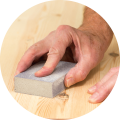When the end user understands the full decorative journey: their motivation to do
preparation work lies in the promise of the end result. Consumers see preparation as
difficult, hard work, messy and time-consuming. And even if they perceive it as a
necessary step in their decorative journey, it is hard for them to find the right products
for the job, raising the purchase barrier even further.
Improve the shopper experience
We need to make it:
Easier Faster Better
Our customers demand 'total care' in instore execution for this
transaction builder segment
Facilitate the total journey: cover the ‘total care’ demand and offer everything from start to finish and create opportunities for (off-the-shelf) new product and product development launches.

The core
The Shopper Decision Tree (SDT) is a piece of generic knowledge that we use as a central theme for all our Category Management activities.
Shopper Decision Tree model
Location
- interior
- exterior

Surface
- mineral
- wood
- tiles
- metal
- polyester, etc

Task
- cleaning
- stripping
- repairing
- smoothing
- priming

Problem scale
- small cracks/seams
- minor damage
- medium-sized damage
- large-scale damage

Benefit
- easy sanding
- extra tough
- very smooth
- quick drying

The Shopper Decision Tree (SDT) is a piece of generic knowledge that we use as a central theme for
all our Category Management activities.
When we structure our assortment, packaging design, POS, website, etc according to the SDT,
we help consumers find the best solution for their specific problem.
This facilitates,
- Penetration easy navigation removes barriers for new entrants in the category

- Up-selling from default choices by finding the exact match with my problem

- Brand-reinsurance this is a brand that understands my needs


